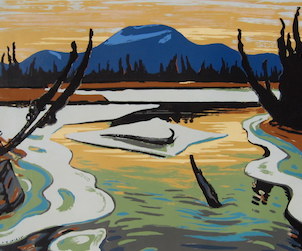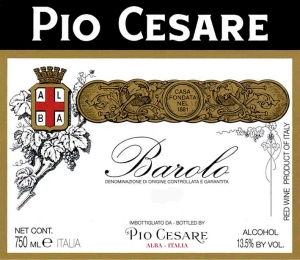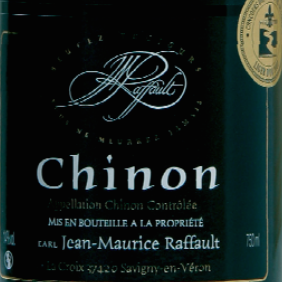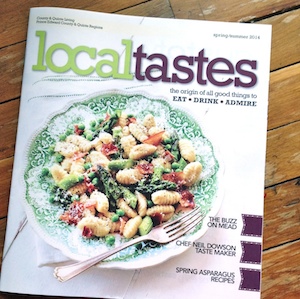Lorette C. Luzajic writes that the world needs more Canada in the latest post in her Wine and Art series.
The six storey bus yellow inflatable duck has long floated away, as has summer, and before Canada’s 150 also fades down the river, I’d like to weigh in on wine and art at the sesquicentennial of our great nation.
This spring, I was in North Africa working on an exhibition with other artists from all over the globe. I was the only Canadian there, and the participants were eager for news and information about my far away land. A few had heard from hard-hitting world news reports that we had a hot prime minister with curly hair and tattoos, and they wanted to know if we had any good writers or artists here as well.
Well.
I pulled out the big guns first, pointing to Margaret Atwood, ready to collude over The Handmaid’s Tale and The Blind Assassin with the new friends toting worn copies of Borges.
There was an all around blank stare.
“Name somebody famous,” someone said finally to break the silence.
Umm… Tom Thomson?
Who?
Whoa.
Douglas Coupland!
Blinking, blinking.
Neil Young?
More blank looks.
Alright then. Canada. Everybody knows this is nowhere.
It was also news to my new friends that we have wine here.
“No, seriously!” I said to painters from Spain and France and Bulgaria, where the wine has flowed from sunshine fountains about three thousand years older than our shy few years of vines.
Everyone roared with laughter.
This afternoon I was fuelling up on espresso at an Indigo Starbucks, and the banner over me said, “The world needs more Canada.”
Here in Canada, we are notoriously modest and restrained. People on the other side of the planet are well aware of the fact that we say sorry if we step on someone else’s foot, but have no idea that we have fantastic wine. And food. And amazing artists, writers, and musicians.
I take this in stride. We will come into our own. There’s a kind of consolation and pride in knowing that our best is yet to come.
Still, we should get used to showing off a bit more. We have bragging rights for peameal bacon sandwiches, Joni Mitchell and ice wine. We have Glenn Gould and Norval Morrisseau and Ed Burtynsky, and those who don’t know them, should. We have Bloody Caesars and basketball, Lynn Crosbie and Gwendolyn McEwen. Jane Siberry, and k.d. lang. We even have our own “appellation of origin” stamp with the initials VQA designating 100% Ontario or B.C. wine.
The world really does need more Canada.
It’s true that Canada’s history of wine and art is sparse, comparatively speaking, to the rest of the world. Our population is small. Our cities are newborns. We don’t have five century old temples and prehistoric vines.
But of course, the land was inhabited before it was called Canada. The many native cultures that were in this land first hold our richest creative history. The northwest coastal Indians’ totem poles are our original skyscrapers, and the Inuit people tell their stories in bone and stone, with the world’s most exquisite sculptures.
And since 1867, there has been a lot more to our story than Bryan Adams and Drake.
We get Leonard Cohen, for one thing, our very own man in black.
Our gloomy troubadour is much better known around the world for his music and poetry than for his visual creations, but I’ve been fortunate enough to see his evocative doodles. They are reminiscent of the drawings of Matisse and sometimes those of Jean Cocteau. But whether through poetry, song, story, or drawing, Cohen’s public journey through darkness to wisdom provided a kind of archetypal catharsis for all of us.
Cohen famously said, “I only drank professionally,” but his favourite wine was not Canadian, it was a Bordeaux: Chateau Latour.
Chateau Latour is in a league of its own. The Wine Cellar Insider describes it as “filled with cassis, earth, truffle, spice and tobacco.” Kind of makes me want to hawk my silver bangle collection on eBay straight away and get some of that.
If in tonight’s heavy end of summer rain, you too find yourself in the mood for Leonard – you want it darker – you can save $390 or so and pour yourself some home grown. Reif Winery offers a Bordeaux blend in its Meritage Red 2012. You’re supposed to leave it for a few more years, but oh, well! No truffles here – rather, a nice, rare jolt of toasted marshmallow hitting the back of your tongue just before a layered and lengthy finishing dance. Tasting note: goes great with vinyl.
Another Canadian treasure with multiple talents is the man accused of bringing the ballet onto ice skates. Flamboyant, larger than life, and formed from elastic rather than the dust of the earth like the rest of us, Toller Cranston took it higher. The Canadian ice queen, who won the 1971–1976 Canadian national championships, the 1974 World bronze medal, and the 1976 Olympic bronze medal, has been called “our Nijinsky.” And for good reason: although his acclaim was for athletics, it was his pure artistry that set him galaxies apart from the competition. Announcers and judges called him the “finest of free skaters,” the “most exotic” and “most bizarre” ice skater they had ever seen.
Cranston was not nearly as demure and humble as the usual national character, and that’s probably one reason he moved to Mexico when he turned 30 and “retired.” It’s a shame, really, that barely anyone knows about his paintings, but after he disappeared he painted more than he ever skated. He completely rejected Canadians’ trademark modesty and touted his talents as being up there with Van Gogh, something that was mocked by the press and his compatriots. Now, the real Van Gogh was much more meek than ours, but I think Cranston was trying to express something parallel about their mutual obsessions. For over thirty years, Cranston spent most of his days painting fanciful, intensely pigmented Russian-Mexican fusion scenes that conjure fairy tales and operas. He created over 30 thousand canvases before he dropped dead.
Contemplating Cranston demands something colourful, balletic and unorthodox. It’s incredible to spend some time with him, watching “amateur skating performances” on Youtube, and scrolling through a few of those thousands of paintings. Such occasions are best spent with a bottle of Niagara’s Big Head Red. The 2016 model is as flamboyant as the artist, a big bold peppery juice fest that feels like a parade.
Canadian art has other trophies. The Group of Seven, and their foundational inspiration, Tom Thomson, cannot go unmentioned. While it is true that Canucks sometimes feel the overkill of the movement’s necessary gravitas, it is amazing how few outside our nation have heard of them. This isn’t a lack of importance- the Canadian wilderness and frontier is as vital to world history as the other essential as any other landscape. Are “Arles” and “Giverny” more “artistic” than the wonders of Algonquin Park or Lake Superior?
These paintings taste better with the kinds of chardonnay that heralds apple cinnamon crumble, or those crisp mineral-dry whites that you could practically scoop right out of a northern spring. You can grab one of those beauties blindfolded off the bounty of Ontario shelves. If you’re in the mood for a worthy splurge, Henry of Pelham Cuvée Catharine Blanc de Blanc 2012 does both – it’s got that delicious chewy apple strudel with nuts and cinnamon quality at first bite- but a well water mineral finish swoops on in to cleanse the palate for the next sip. Outstanding.
One of Canada’s greatest works of art is Anne of Green Gables, a spitfire sprite of a girl written into being by Lucy Maud Montgomery. Anne is the heroine of a remarkable, humanist, feminist novel that addresses every single theme of great literature. Would it be too cute to pair Anne with orange wine, if only to piss her off about her infamous carrot braids? If so, indulge me, because the temptation can’t be resisted. Southbrook’s Orange Wine is a perfect accompaniment to Anne’s temperament, blending the acerbic and honey into one perfect character.
There is too much Can-con for me to do justice to the wealth. If we come up short sometimes at the world table, the reasons are obvious: we are young, and we are few. With these realities factored in, we are already over represented with creative geniuses and brilliant wines.
Gordon Lightfoot is Canada. Ryan Gosling is ours – he’s a brilliant actor. Batteries! Insulin. Arcade Fire. The English Patient.
When it comes to Canadian wine, I’m no jingoist. More honestly, I’m a Spanish wine fetishist. Forget my heart – half my liver belongs to Spain and her heirs.
But it’s a mistake to neglect what’s right here. We have a magnificent world of wine.
As in all things, I am one who craves variety, so I must sip around.
But I must also stay home and meet the people in my community. I’m committed to taking in as many of my local beverages as I can. I actually get prickly when professional or casual company tries to slough Canada from the wine list. No way you don’t. Leave your preconceived notions at the door, and taste the future.
Riesling. Appassimento-style reds. Old vine baco noirs. We are damned good, oh, Canada.
And Canadian art – so good, and getting better and better.
Yes, I want more, too, and so I’m making some.








